If you want to know about the Egyptian architecture or roman architecture or byzantine architecture, please click the link.
Gothic architecture (12 – 15th century) Gothic architecture began mainly in France, where architects were inspired by Romanesque architecture and the pointed arches of Spanish Moorish architecture. It is easy to recognize Gothic buildings because of their arches, ribbed vaulting, flying buttresses, elaborate sculptures (like gargoyles) and stained-glass window. Gothic architecture was originally known as “French Style”.
Gothic architecture is a European style of architecture that values height and exhibits an intricate and delicate aesthetic. Though its roots are French, the Gothic approach can be found in churches, cathedrals, and other similar buildings in Europe and beyond. Examples of Gothic architecture: Notre Dame Cathedral in Paris and St. Patricks Cathedral in Dublin.
1) Influences
History
- 12th – 13th centuries: Holy Roman Empire was reduced to the area of Germany Only 3 great kingdoms were left: France, England and Castile in Spain
- Prosperous years in terms of agriculture – warm weather and invention of the windmill and watermill increased the amount of food produced
- Most Europeans were Catholics
- Church under the Pope brought Christians together
- Entire Christianity was united against Muslims
- The rulers, the church and townspeople spent wealth on building more castles, cathedrals and monasteries
- Towns competed with each other to produce the best architecture.
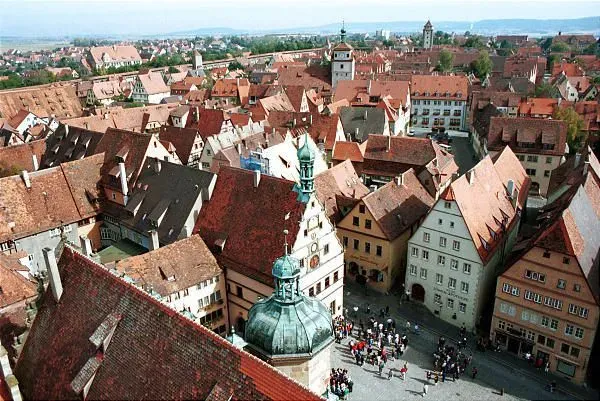
- Some 4000 new towns were built to accommodate the rising population
- Towns became centers of trade – Paris, Milan, Florence, Venice, Naples
- Mixture of lands ruled by nobles
- Feudal system – landlords ruled with tyranny
- There was restlessness among the people
- Towns became crowded and dirty – disease was rife

2) Architectural character
- “Gothic” is a term used in reproach to this style
- a departure from classic lines
- Can be identified by the general use of pointed arch
- Also called “Medieval Architecture”
- Structural – Skeletal stone structure
- Visual – Visual art were important including the role of light in structures.
- Symbolic – i) Scholasticism, ii) Translations of real events into stone and glass, iii) Cathedrals served as an image of heaven
i) Characteristics of gothic architecture
- Gothic architecture mainly: i) Airy and bright, ii) Focus on verticality, iii) Pointed arches, iv) Rib vaults, v) Flying buttresses, vi) Large stained-glass windows, vii) Ornaments and pinnacles etc..

ii) Pointed arch

- Gothic architecture is not merely about ornamentation.
- The Gothic style brought innovative new construction techniques that allowed charches and other buildings to reach great heights.
- One important innovation was the use of pointed arches.
- During the Gothic era, Builders discovered that pointed arches would give structures amazing strength and stability.
- Builders turned from the semicircular, unbroken arch to the pointed arch
- Looked lighter and pointed upward.
iii) Ribbed Vault

- Organic metaphor alluding to the role of ribs in anatomy as the body’s skeletal structure supporting tissues.
- Arches, usually three pairs per rectangular bay, running diagonally.
- Cross ribs act together with outer frame to create a complete armature of arches along the edges and main folds of the vault.
- Earlier Romanesque churches relied on barrel vaulting. Gothic builders introduced the dramatic technique of ribbed vaulting.
- While barrel vaulting carried weight on continuous solid walls, ribbed vaulting used columns to support the weight
- The ribs also delineated the vaults and gave a sense of unity to the structure.
iv) Flying Buttress
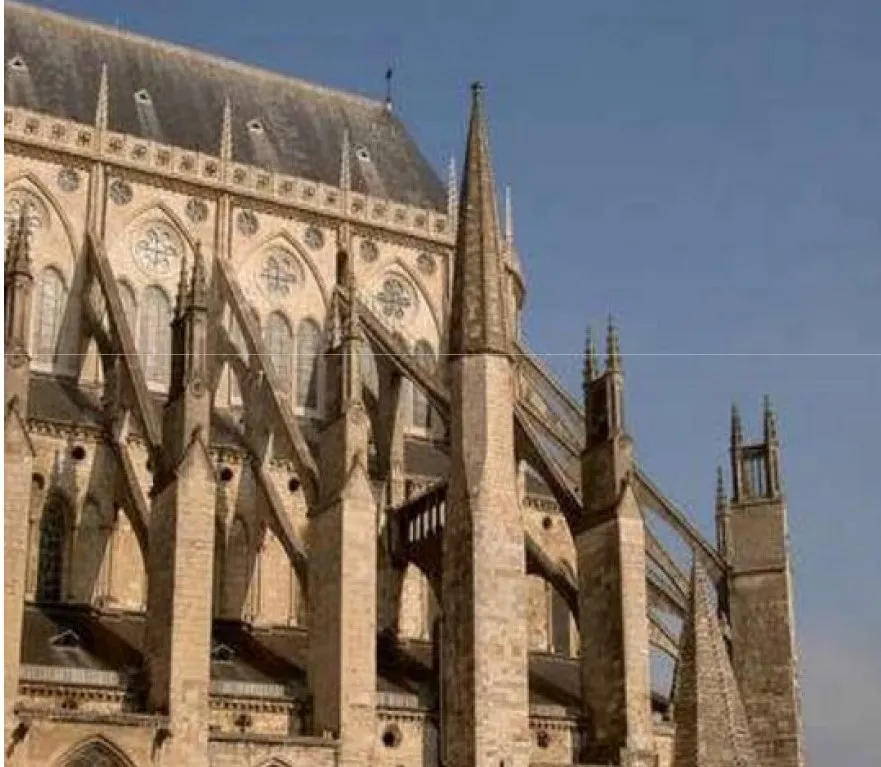
- In order to prevent the outward collapse of the arches, Gothic architects began using a revolutionary “ flying buttress” system.
- Freestanding brick or stone supports were attached to the exterior walls by an arch or a half-arch.
v) Stain Glass window

- Since the walls themselves were no longer the primary supports, Gothic buildings could include large areas of glass.
- Huge stained-glass windows and a profusion of smaller windows created the effect of lightness and space.
vi) Gargoyles

- Cathedrals in the high Gothic style became increasingly elaborate.
- Over several centuries, builders added towers, pinnacles, and hundreds of sculptures.
- In addition to religious figures, many Gothic cathedrals are heavily ornamented with strange, leering creatures.
- These gargoyles are not merely decorative.
- Originally, the sculptures were waterspout to protect the foundation from rain.
- Since most people in Medieval days could not read, the carvings took on the important role of illustrating lessons from the from the scriptures
3) Gothic architecture in France
- French Gothic architecture is an architectural style which emerged in France in 1140, and was dominant until the mid-16th century.
- The most notable examples are the great Gothic cathedrals of France, including Notre-Dame Cathedral, Reims Cathedral, Chartres Cathedral, and Amiens Cathedral.
- In French, “L’architecture Ogivale“
- Primaire (12th Century AD). Also called “a lancettes”
- Distinguished by pointed arches and geometric traceried windows
- Secondaire (13th Century AD). Also called “Rayonnant”
- Characterized by circular windows with wheel tracery
- Tertiare (14th to 16th Century AD). Also called “Flamboyant”
- Flame-like window tracery or free-flowing tracery
i) Features
- Use of pointed arch to cover rectangular bays
- Use of flying buttresses weighted by pinnacles
- Tall, thin columns – “stretching up as if to heaven”
- Walls released from load-bearing function
- Invention of colored, stained glass windows to adorn window-walls
- Tracery windows provided a framework for Bible stories to be told in pictures
- Cathedrals as a library for illiterate townspeople – Biblical stories were told with stained-glass and statuary
a) Amiens Cathedral
- The tallest completed french gothic church
- Begun in 1220 and finished by 1269
- Scale is truly gigantic
- Portals dwarf the worshiper
- Rose window is dwarfed by the immense façade
- The aisle vaults rise come 60 ft. from the inside
- The glass creates the sensation of being within a huge fragile cage.
- Architect – Robert de Luzarches


b) Reims Cathedral
- Begun in 1211 after fire has destroyed the previous structure
- Based on chartres
- Features a greater sensation of height by adjusting the proportions of the nave
- Most glorious view is from it west front

c) Chartres Cathedral
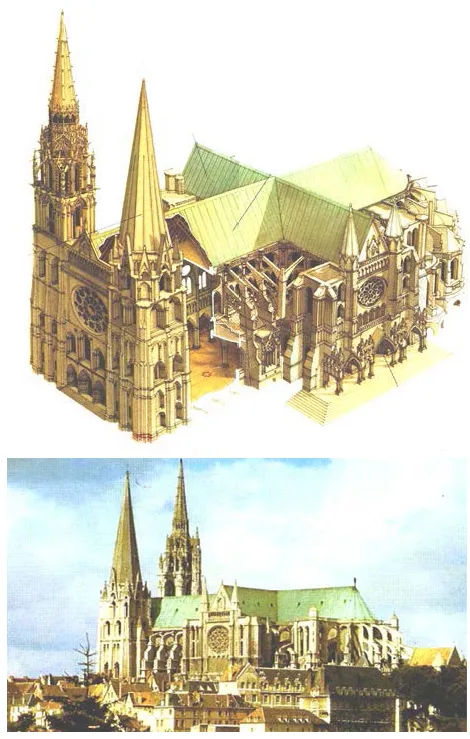
d) Notre Dame, Paris
- One of the oldest French cathedrals
- Begun by Bishop Maurice de Sully
- Façade features successive tiers of niches with statues: Christ and French kings
- Central wheel window
- Two western towers with high pointed louvred openings
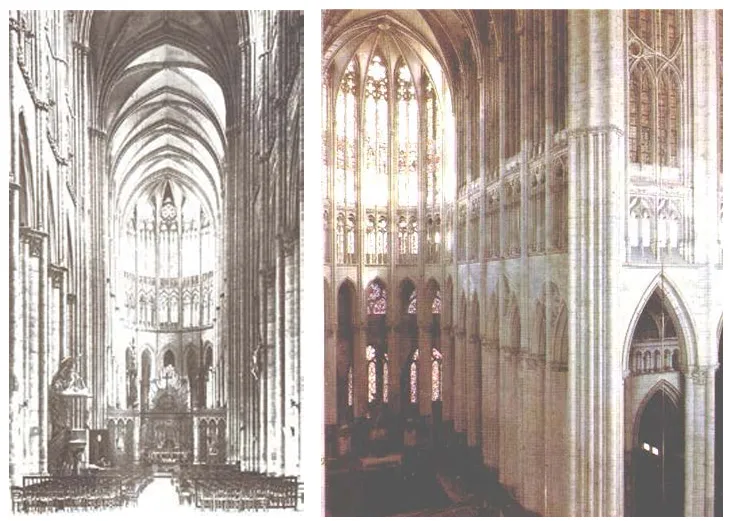
Other cathedrals: Beauvais Cathedral, Laon Cathedral, Soissons Cathedral
4) Gothic architecture in Britain (England)
- Gothic architecture in Britain has been neatly divided into periods, or styles.
Norman (1066 to 1154 AD)
- Includes the raising of most of major Romanesque churches and castles
Transitional (1154 to 1189 AD)
- Pointed arches in Romanesque structures
Early English (1189 to 1307 AD)
- Equivalent to High Gothic in France
- Also called “Lancet” or “First Pointed” style, from long narrow pointed windows
Decorated (1307 to 1377 AD)
- Window tracery is “Geometrical” in form, and later, flowing tracery patterns and curvilinear surface pattern
- Also called “Second Pointed”, equivalent to French “Flamboyant” style PERPENDICULAR (1377 to 1485 AD)
- Also called “Rectilinear“ or “Third Pointed”
Tudor (1495 to 1558 AD)
- Increasing application of Renaissance detail
Elizabethan (1558 to 1603 AD)
- Renaissance ideas take strong hold
a) Cathedrals
- May have been attached to monasteries or to collegiate institutions
- Found in precincts with dormitories, infirmary, guest houses, cloisters, refrectory, other buildings

- Complex of church, royal palace and burial grounds
- Most important medieval building in Britain
- widest (32 m) and highest vault in England (102 ft)
b) Other examples
- Wells Cathedral
- York Cathedral – largest medieval cathedral in England and in Northern Europe
- Winchester Cathedral – longest medieval cathedral in England
5) Germany, Belgium and The Netherlands (Gothic Architecture)
- In Germany, the chief influence came from France, not from German Romanesque
- In Belgium and The Netherlands, it was based on French Gothic, developing the Brabantine style
a) Hall churches
- Had a different look:
- Nave and aisle of same height
- One or two immense and ornate western towers or apse, in place of sculptured doorway
- Brick-work and simplified ornamentation

- Typical hall church
6) Spain (Gothic Architecture)
- Strong Moorish influences: the use of horseshoe arches and rich surface decoration of intricate geometrical and flowing patterns
- Churches had flat exterior appearance, due to chapels inserted between buttresses
- Excessive ornament, without regard to constructive character
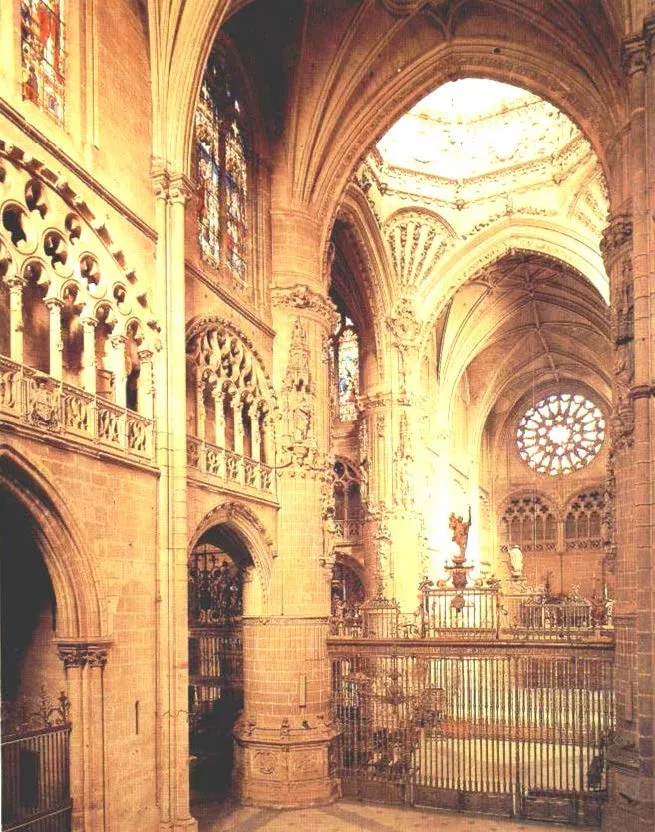
a) Burgos Cathedral (1221 – 1457 AD)
- Irregular in plan
- Most beautiful and poetic of all Spanish cathedrals Seville
b) Cathedral (1402 to 1520 AD)
- Largest Medieval church in Europe
- Second largest church in the world, next to St. Peter’s, Rome

c) Other cathedrals
- Avila Cathedral, Segovia Cathedral, Barcelona Cathedral
7) Gothic in Italy
- In 1300s Italy was loose collection of republic city states with political differences
- Rise of merchant class to Nobility
- Guelph (pro Pope city states eg . Florence)
- Gibelline (pro Holy Roman Emperor city states eg. Sienna)
- Led the way in Europe, in terms of art, learning and commerce
- Cultural revival was taking place in Italy in advance of northern Europe
- Roman tradition remained strong
- This arrested the development of Gothic architecture in Italy
- Verticality of Gothic is generally neutralized by horizontal cornices and string courses
- Absence of pinnacles and flying buttresses
- Small windows without tracery
- Projecting entrance porches with columns on lion-like beasts

a) Florence Cathedral or S. Maria del Fiore
- Designed by Arnolfo di Cambio
- Essentially Italian in character, without the vertical features of Gothic
- Peculiar latin cross plan with campanile and baptistery

b) Siena Cathedral
- One of most stupendous undertakings since the building of the Pisa cathedral
- Outcome of civic pride – all artists in Siena contributed their works to its building and adornment
- Cruciform plan
- Zebra marble striping on wall and pier
c) Other cathedrals
- Milan Cathedral
- Largest Medieval cathedral in Italy
- 3rd largest cathedral in Europe
Overall, Gothic architecture was a major development in the history of architecture and had a lasting impact on the design and construction of buildings throughout Europe. Its ornate style, rich decoration, and emphasis on height and light remain defining characteristics of the Gothic style and continue to inspire architects and designers today.